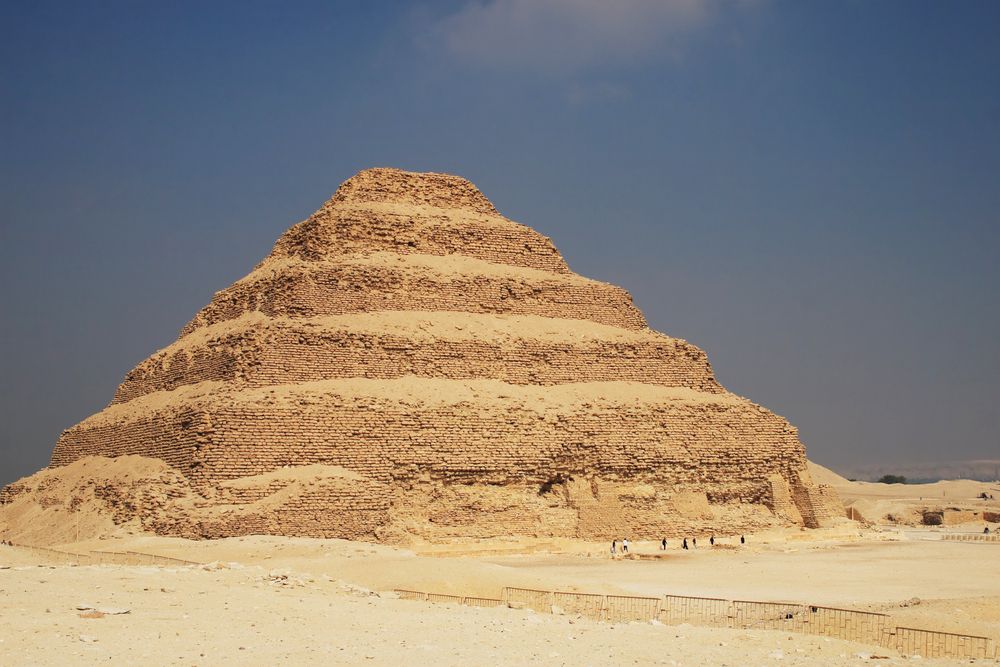Ravi
Senior Member.
Came across a video about Egyptian artisans that try to keep the crafts alive. Check this part (t=1852), about stone vases..

Source: https://youtu.be/8e0G51TYHy8?t=1852
Source: https://youtu.be/8e0G51TYHy8?t=1852
Fascinating, thank you! One thing that surprises me is that he doesn't have a fixed mount for his drill and his larger pieces - he just embeds them in the ground, and holds the drill by hand. Of course, that was a deliberately low precision large piece, perhaps he has a more refined setup for the more delicate pieces, but still, if the drill was mounted in a frame it would obviously be less physical effort - he'd only need to worry about applying the axial turning force and some downwards, and not have to worry about the drilling axis itself being kept upright. Maybe he's from a village of stoneworkers, and skilled carpenters, and ergonomics consultants, are hard to come by!Came across a video about Egyptian artisans that try to keep the crafts alive. Check this part (t=1852), about stone vases..
It wouldn't be considered "advanced" by us because it'd be a fairly manual technique, but still there's a chance no craftsman (or -woman) today could match the ancient top craftsman if you took away their power tools.
I agree it wouldn't feel like "advanced" technology to us because we can now achieve the same result with less effort.
Just to start let's get who the host is:Ban van Kerkwyk worked together with some metrologist to get some measurements on a vase made out of rose granite from a private collection of ancient Egyptian artificats.
https://jermwarfare.com/conversations/ben-van-kirkwykBen Van Kerkwyk is a researcher and creator of UnchartedX, a website and YouTube channel looking into ancient mysteries, presenting new ideas about humanity’s past.
He has been travelling the world for decades, filming ancient sites and interviewing leading historians, which has taken him on a journey of suspicion surrounding established history. (The establishment must always be viewed with a sceptical eye. Just like “trusting the science” is a bad move, so is “trusting the history”.)
I believe there is a need for high quality content that addresses the new science and new discoveries that should affect how we view the past, and to examine the contradictions that are clearly evident on ancient sites, and in our orthodox version of history.
Ben Van Kirkwyk
Came across a video about Egyptian artisans that try to keep the crafts alive. Check this part (t=1852), about stone vases..
Source: https://youtu.be/8e0G51TYHy8?t=1852
Thanks!Just saying, shout out to @Ravi for this heads up. Watched this one last night and the Mrs. and I are into another episode tonight. Very interesting and giving the amount of crap that is on TV/YouTube very informative.
https://www.msn.com/en-us/news/tech...ing-giant-logs-to-their-foreheads/ar-AA17TXVAThe ancestral Puebloans that called Chaco Canyon home a millennium ago used more than 200,000 pieces of timber to construct their buildings, with weights estimated between 185 and 605 pounds per log. But the area around Chaco Canyon is a dry, arid climate that likely didn’t have many high-quality, usable trees. And indeed, in 2001, tree-ring experts at the University of Arizona used chemical analyses to pinpoint that the wood was sourced from mountain ranges up to 46 miles away. But that finding left them with even more questions.
Now a new study published on February 22 in the Journal of Archaeological Science presents a reasonable explanation: The Puebloans used a simple piece of fabric looped around their heads.
A tumpline refers to a strap attached on both ends to a sack of equipment like a basket or a backpack. But instead of carrying it over their shoulders, the ancient log bearers would have placed it on their heads, just behind the hairline. Then, by leaning forward, the carriers distributed the weight of their cargo down the neck and spine. Anthropologists know that pre-Columbian cultures in America used tumplines woven from plant fibers to transport heavy loads, but up until recently, had never tested the method on the Chaco Canyon timbers.
A medieval windmill is a machine made almost entirely from wood. Since they've fallen out of use, few remnants remain.
(CC BY-SA, by Arto J)
People today still routinely live in houses made of baked bricks stuck together with mortar, but no one would call them primitive dwellings.
I second this.
Isn't there a definitional problem also in that there's a lack of clarity around what tools and techniques an "advanced" ancient civilization might have had? I also don't think it's fair to deride precision granite stone-working as primitive. People today still routinely live in houses made of baked bricks stuck together with mortar, but no one would call them primitive dwellings.
As another example, the Antikythera mechanism is presumably millennia younger than any of these structures, but who built it, how, where are the tools, where are the precursors designs, etc. One could argue that that seems to be a similar case of a mysterious object with no known antecedents, with perhaps ancient master guilds passing on knowledge by word of mouth and the training of apprentices until war or famine or pestilence struck and the knowledge was lost.
Isn't there even a hint of truth to the idea that these structures are orders of magnitude bigger and more accurate than anything before or for millennia afterwards, and that in itself is peculiar? The use of tubular drills, for example, seems to have been widespread in Egypt, but then vanished until the industrial revolution brought them back into use.
Likewise, what global population existed during the suggested time period and where was it based? The lack of evidence isn't, perhaps, that hard to understand if 95% of a few million people lived on the coastline of a world that's been submerged at a depth of several hundred metres for 9k to 10k years.
Isn't there a definitional problem also in that there's a lack of clarity around what tools and techniques an "advanced" ancient civilization might have had?
maybe there is a galactic directive to not interfere with developing species, but one alien architect just couldn't STAND it (the unlevel rocks) and interfered. He probably has an official reprimand in his file and maybe even got fired."Hey, you know, if you guys chisel out some blocks, you can then stack them on top of each other to make a mound. If you get enough people together to do this, you can make a big mound.
And here's a secret, since you're just going to be piling theses blocks up and not connecting them together in any way, make each level a little smaller than the one below it so you end up with a mountain shaped mound
https://en.m.wikipedia.org/wiki/Past_sea_levelLikewise, what global population existed during the suggested time period and where was it based? The lack of evidence isn't, perhaps, that hard to understand if 95% of a few million people lived on the coastline of a world that's been submerged at a depth of several hundred metres for 9k to 10k years.
Article: Around 7,600 years ago, the emergence of agricultural settlements in Southeastern Europe and subsequent progress of civilization suddenly came to a standstill. This was most likely caused by an abrupt sea level rise in the northern Aegean Sea. Researchers of the Senckenberg Biodiversity and Climate Research Centre, the Goethe University in Frankfurt and the University of Toronto have now detected evidence of this oceanographic event and an earlier sudden sea-level rise in the fossils of tiny calcifying marine algae preserved in seafloor sediments in the Aegean Sea.
"Approximately 7,600 years ago, the sea level must have risen abruptly in the Mediterranean regions bordering Southeastern Europe. The northern Aegean, the Marmara Sea and the Black Sea recorded an increase of more than one meter. This led to the flooding of low-lying coastal areas that would have been ideal areas for settlement," says lead author Professor Dr. Jens Herrle of the German Senckenberg Biodiversity and Climate Research Centre and Goethe University.
Seriously, there are persons on YT that answer this -what lost tech?- by "clearly they had 5 axis CNC capability".
Agreed. But, the culture described in the article is 7,600 years ago:However, in theory the idea is sound: sea level rise could forcd a social change that changes technological traditions: not because the tools get flooded and the artisans drown, but because the wealth that supported them is no longer there.
Article: Around 7,600 years ago, the emergence of agricultural settlements in Southeastern Europe and subsequent progress of civilization suddenly came to a standstill. This was most likely caused by an abrupt sea level rise in the northern Aegean Sea. Researchers of the Senckenberg Biodiversity and Climate Research Centre, the Goethe University in Frankfurt and the University of Toronto have now detected evidence of this oceanographic event and an earlier sudden sea-level rise in the fossils of tiny calcifying marine algae preserved in seafloor sediments in the Aegean Sea.
Meaning, despite a catastrophe, they are aware of the societies technology level and the limits reached, unlike the Atlantean technology, for which there is no evidence at all.subsequent progress of civilization suddenly came to a standstill
The problem with the idea of a culture existing 10,000 years ago having passed technology to the Egyptians is that Egypt really only took off 3150 bc, aka 5000 years ago: the idea of technology making it across those prehistoric 5000 years through cuneiform or hieroglyphs that have since been lost feels implausible when that same technology failed to be preserved through the 5000 years that followed.
I'm never going to accept that ancient people had steamships and the telegraph, but are we so sure there wasn't a cataclysm that could account for a sudden loss of general entry-level civilization (maths, literacy, stone working, basic navigation, celestial observation, shipbuilding, etc)? There is also real evidence of some kind of meteor impact over the northern ice cap and a big rush of water into the Atlantic?It doesn’t make much sense that a culture/civilization had some advanced technology/techniques but couldn’t notice a gradual rise in sea levels so they could move inland and preserve the technology.
I was just watching a program last night about Doggerland, the now underwater region between Britain and mainland Europe. It was an area the size of Germany that was gradually disappearing as the glaciers melted and the waters rose, but then, 8000 years ago, experienced a massive tsunami due to a sub oceanic landslip off Norway known as the Storegga slide. We have seen the huge destruction caused by two major tsunamis in this century alone, and it seems likely to me that in a day before world-wide communication, such an event would, literally, wipe out some cultures to the point that we still have yet to identify them.I'm never going to accept that ancient people had steamships and the telegraph, but are we so sure there wasn't a cataclysm that could account for a sudden loss of general entry-level civilization (maths, literacy, stone working, basic navigation, celestial observation, shipbuilding, etc)?
It's really not that hard to believe, I feel, that an ancient "Athens" of 100k people could have existed somewhere now underwater, risen to a certain level of sophistication, and been wiped out for who knows what reason, leaving only telltale traces through survivors' tales.
https://www.britannica.com/topic/hunter-gathererSocial groups are necessarily small, because only a limited number of people can congregate together without quickly exhausting the food resources of a locality. Such groups typically comprise either extended family units or a number of related families collected together in a band. An individual band is generally small in number, typically with no more than 30 individuals if moving on foot, or perhaps 100 in a group with horses or other means of transport.
https://en.wikipedia.org/wiki/WheatArchaeological analysis of wild emmer indicates that it was first cultivated in the southern Levant, with finds dating back as far as 9600 BC.[18][19] Genetic analysis of wild einkorn wheat suggests that it was first grown in the Karacadaǧ Mountains in southeastern Turkey. Dated archaeological remains of einkorn wheat in settlement sites near this region, including those at Abu Hureyra in Syria, suggest the domestication of einkorn near the Karacadaǧ Mountains.[20] With the anomalous exception of two grains from Iraq ed-Dubb, the earliest carbon-14 date for einkorn wheat remains at Abu Hureyra is 7800 to 7500 years BC.[21]
https://en.wikipedia.org/wiki/RiceThe current scientific consensus, based on archaeological and linguistic evidence, is that Oryza sativa rice was first domesticated in the Yangtze River basin in China 13,500 to 8,200 years ago.[31][32][33][34]
https://en.wikipedia.org/wiki/MaizeAn 2002 study by Matsuoka et al.. has demonstrated that, rather than the multiple independent domestications model, all maize arose from a single domestication in southern Mexico about 9,000 years ago. The study also demonstrated that the oldest surviving maize types are those of the Mexican highlands. Later, maize spread from this region over the Americas along two major paths. This is consistent with a model based on the archaeological record suggesting that maize diversified in the highlands of Mexico before spreading to the lowlands.[15][16]
https://en.wikipedia.org/wiki/JerichoJericho has evidence of settlement dating back to 10,000 BCE.
https://www.discovermagazine.com/pl...nt-city-is-considered-the-oldest-in-the-worldBut the earliest region for urbanization was the Middle East, with ancient Mesopotamia. About 10,000 years ago, soon after farming began there, the site of Jericho in present-day West Bank featured massive stone walls, enclosing a settlement of an estimated 2,000 to 3,000 residents. By 9,000 years ago, Çatalhöyük, located in present-day Turkey, likely held several thousand people in houses made of mud brick and plaster.
The Caral culture developed between 3000 and 1800 B.C (Late Archaic and Lower Formative periods). In America, it is the oldest of the pre-Hispanic civilizations, developing 1,500 years earlier than the Olmec civilization, the first Mesoamerican complex society.[4]
The date of 2627 BC for Caral is based on the carbon dating of reed and woven carrying bags that were found in situ. These bags were used to carry the stones for the construction of the temples. The material is an excellent candidate for high precision dating. The site may date even earlier, however, as samples from the oldest parts of the excavation have yet to be dated.[12]
https://en.wikipedia.org/wiki/CaralCaral had a population of approximately 3,000 people. However, 19 other sites in the area (posted at Caral), allow for a possible total population of 20,000 people sharing the same culture in the Supe Valley.
The original director of excavations, Klaus Schmidt, thought the site was purely ritualistic and was constructed by hunter-gathers that would come together periodically to build and use the site:Radiocarbon dating of charcoal found in the four enclosures currently being excavated show that Layer III dates back to approximately 9990 to 9250 BCE, with charcoal samples from Enclosure D appearing to be slightly older than Enclosures C and A
Others are not so sure, and think people may have lived there:Schmidt believed firmly that Göbekli Tepe is the first known religious site.[5] He believed that the resources surrounding the site could not support a community of hunter-gatherers. He also believed that the reliefs present on the limestone pillars were too ornate and that the columns were too massive for a mere residential use. Additionally, at present, there is no source of water close to the site, which would be an impediment to the existence of a permanent residential community. Schmidt also claims that the structures had no roofs, so they would not be habitable.
http://www.fakearchaeology.wiki/index.php/Göbekli_TepeMany of Schmidt's claims regarding the cult purpose of Göbekli Tepe can be addressed with the preliminary nature of the excavations. According to Schmidt himself, the site is 5% excavated. This leaves massive room for future findings that could explain the true purpose of the site, religious or otherwise.
As noted in Banning's paper entitled "So Fair a House: Göbekli Tepe and the Identification of Temples in the Pre-Pottery Neolithic of the Near East," Banning points out that there are many examples of ritual structures in relatively mundane locations, like habitations.[8] Additionally, in response to the claim that the enclosures could not have been habitable because they did not have roofs, Banning points out that the columns could have structural purpose in supporting a roof. The columns in the middle of the enclosures of Layer III are typically taller than those on the border of the structures.[8] Further analysis of the drainage patterns and weathering of the limestone tiled floors of the structures could also provide answers as to the presence or absence of roofs in the enclosures.[8]
Finally, there is still question as to where the debris that filled the site originated. Schmidt claims that the debris did not originate from Göbekli Tepe, although there are no contemporary sites within 14 km.[8] Also, the amount of debris required to fill the site would require massive amounts of time in transporting the debris from another site. Banning asserts that it is more likely that the debris came from either a small group of permanent inhabitants at the site that was frequented by visitors, or that the site was home to a large residential population that produced the debris themselves.[8] Given the effort required to procure the debris from the closest site, it is most likely that the debris was produced at Göbekli Tepe itself.
https://www.britannica.com/topic/hunter-gathererPermanent villages or towns are generally possible only where food supplies are unusually abundant and reliable; the numerous rivers and streams of the Pacific Northwest, for instance, allowed Native Americans access to two unusually plentiful wild resources—acorns and fish, especially salmon—that supported the construction of large permanent villages and enabled the people to reach higher population densities than if they had relied upon terrestrial mammals for the bulk of their subsistence.
https://en.wikipedia.org/wiki/Hunter-gathererSome hunter-gatherer cultures, such as the indigenous peoples of the Pacific Northwest Coast and the Yokuts, lived in particularly rich environments that allowed them to be sedentary or semi-sedentary. Amongst the earliest example of permanent settlements is the Osipovka culture (14–10.3 thousand years ago),[17] which lived in a fish-rich environment that allowed them to be able to stay at the same place all year.[18] One group, the Chumash, had the highest recorded population density of any known hunter and gatherer society with an estimated 21.6 persons per square mile.[19]
That aside, though, hasn't civilisational collapse happened over and over anyway, with or without some major apocalypse being the cause?
Article: Despite the widespread modern belief that the Library of Alexandria was burned once and cataclysmically destroyed, the Library actually declined gradually over the course of several centuries.
That aside, though, hasn't civilisational collapse happened over and over anyway, with or without some major apocalypse being the cause?
The Babylonians. The Maya. The Olmecs. The Minoans. The Easter Islanders. Greenland Norse. Angkor Wat. Egypt. Even ignoring all claims about supposed precursor civilisations, the Egyptians themselves were highly civilised for millennia, yet they effectively disappeared, and by the time the Victorians came on the scene, no one had read a hieroglyph in several millennia and the sphinx was up to its neck in sand again.
https://en.wikipedia.org/wiki/Spanish_conquest_of_YucatánThe Spanish conquest of Yucatán was the campaign undertaken by the Spanish conquistadores against the Late Postclassic Maya states and polities in the Yucatán Peninsula, a vast limestone plain covering south-eastern Mexico, northern Guatemala, and all of Belize.
I read an interesting non-fiction book (can't remember the author) but it was written by a woman who left England for Egypt a century or so ago. She commented on the annual rebuilding of the levees after the Nile floods. Each village was given a quota of the number of men to be sent to do the work, and each man brought his own rations for several weeks and came to fix the levees. She describes it as somewhat of a good-natured competitive event between the various gangs. I read that and thought that the building of pyramids might well have been done in that manner, each village sending a certain number of workers for a period of time, then all of them going home to tend their own farms.The term "disappear" needs to be used with care. When using the phrase to describe Egypt for example, dynasties and invaders came and went, but every year for the last 5000+ years farmers along the banks of the Nile have planted and harvested crops, there were always people there. The people who built Gobekli Tepe disappeared, as in gone, with no living descendants we know of.
Some say the Egyptians also already used some form of 'concrete' and cast them into shape.Still doesn't explain how the Egyptians did it, but nevertheless fascinating.
The sample chemistries the researchers found do not exist anywhere in nature. "Therefore," says Barsoum, "it's very improbable that the outer and inner casing stones that we examined were chiseled from a natural limestone block."
More startlingly, Barsoum and another of his graduate students, Aaron Sakulich, recently discovered the presence of silicon dioxide nanoscale spheres (with diameters only billionths of a meter across) in one of the samples. This discovery further confirms that these blocks are not natural limestone.
Although some say the evolution of the build doesn't match up since after the "three great ones" all pyramids that have been, tried to, build are of far lesser quality and construction; as if they had lost a lot of knowledge on how to build them.You see a very clear pattern of technological development together with material and economic constraints being determining factors to the size and shape of the pyramids. Why would this be so, if they were built by aliens / atlanteans / ultraterrestrials / snakelike brain parasites posing as gods? They'd have their technique nailed down, and they wouldn't necessarily need to source the material locally either.
Some say the Egyptians also already used some form of 'concrete' and cast them into shape.
I am pretty certain this is also not true (that the way to make pyramids was lost). That we do not know how they exactly did it, does not mean it could not have been done.Although some say the evolution of the build doesn't match up since after the "three great ones" all pyramids that have been, tried to, build are of far lesser quality and construction; as if they had lost a lot of knowledge on how to build them.
No, what I'm trying to say is that some people theorize the 3 or 4 big/famous pyramids don't fit into the picture of the evolution of the pyramids;I am pretty certain this is also not true (that the way to make pyramids was lost). That we do not know how they exactly did it, does not mean it could not have been done.
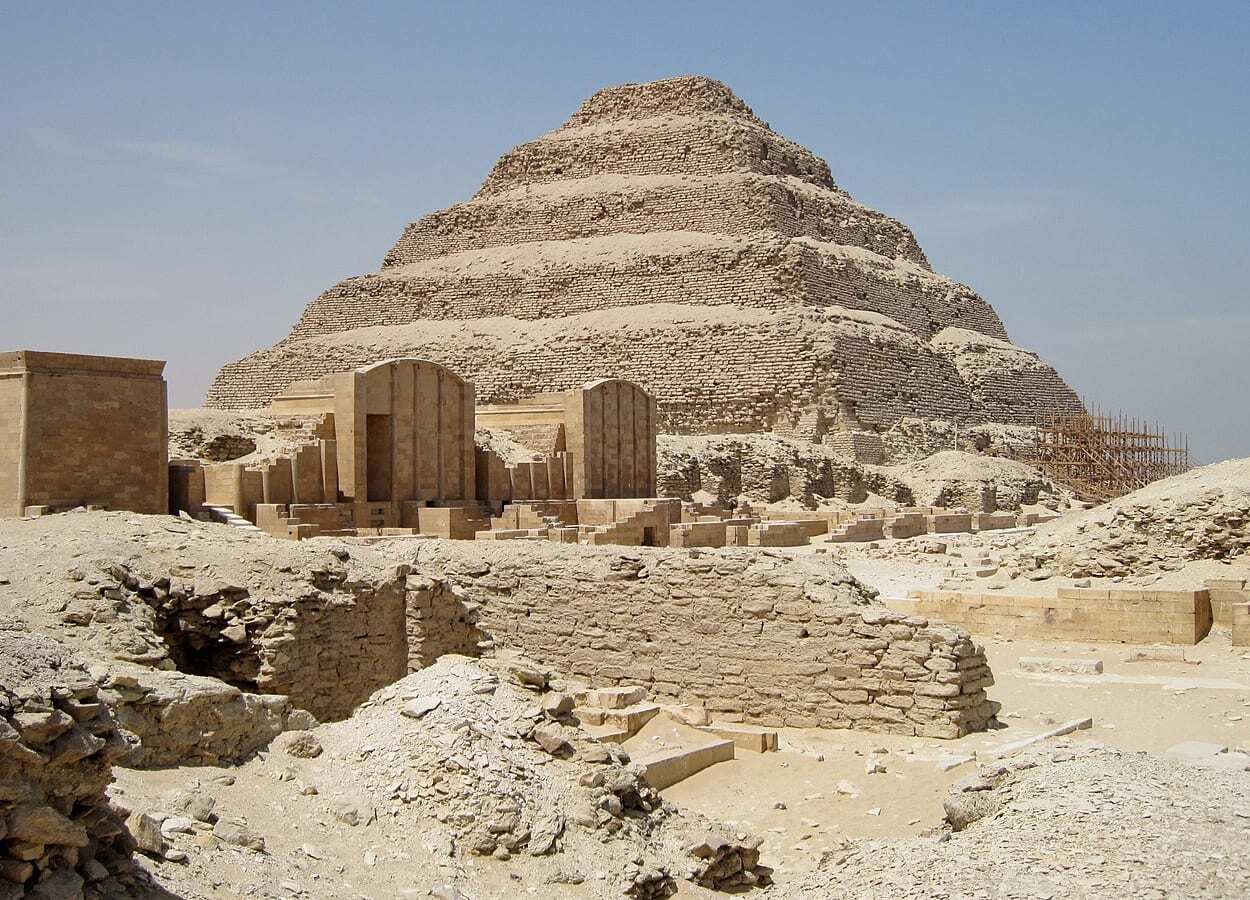
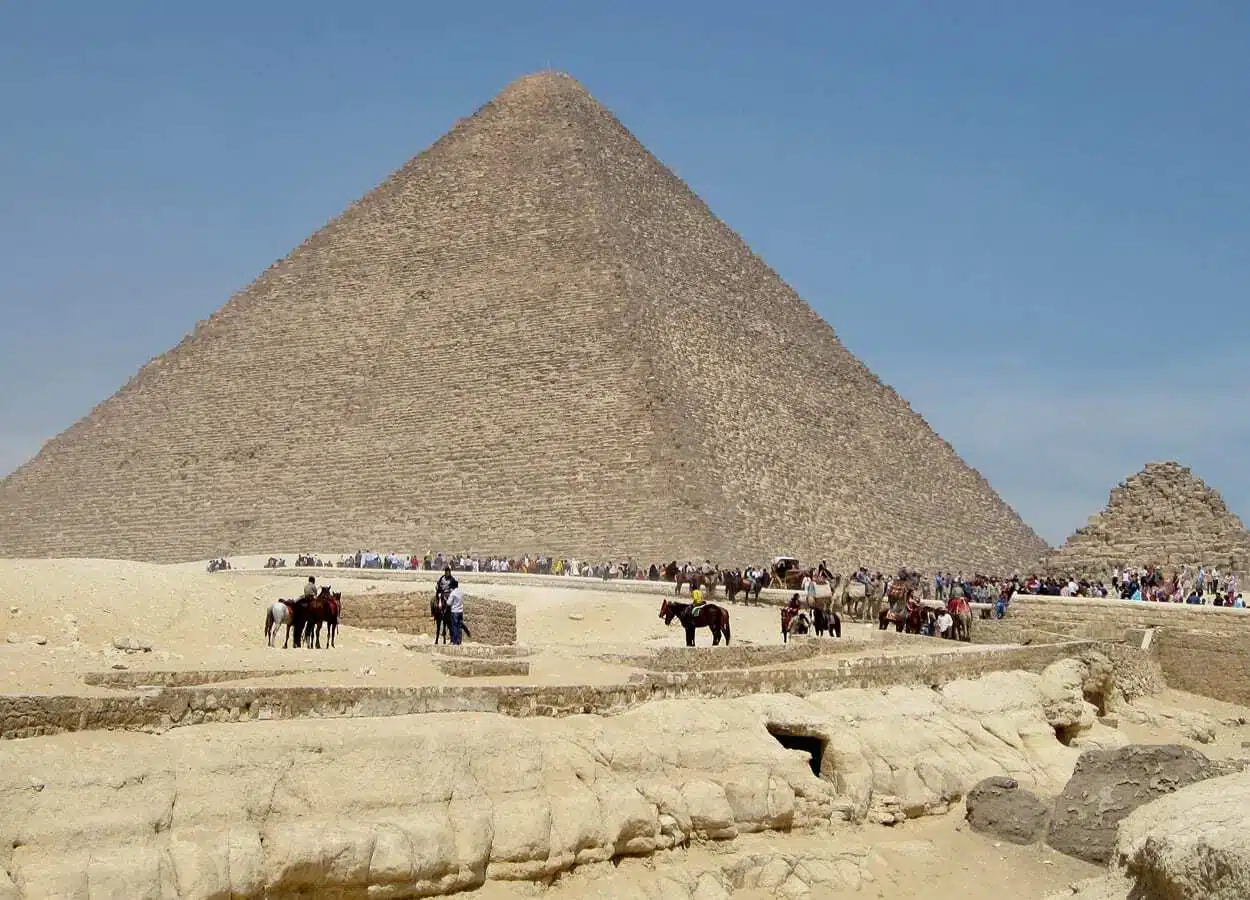
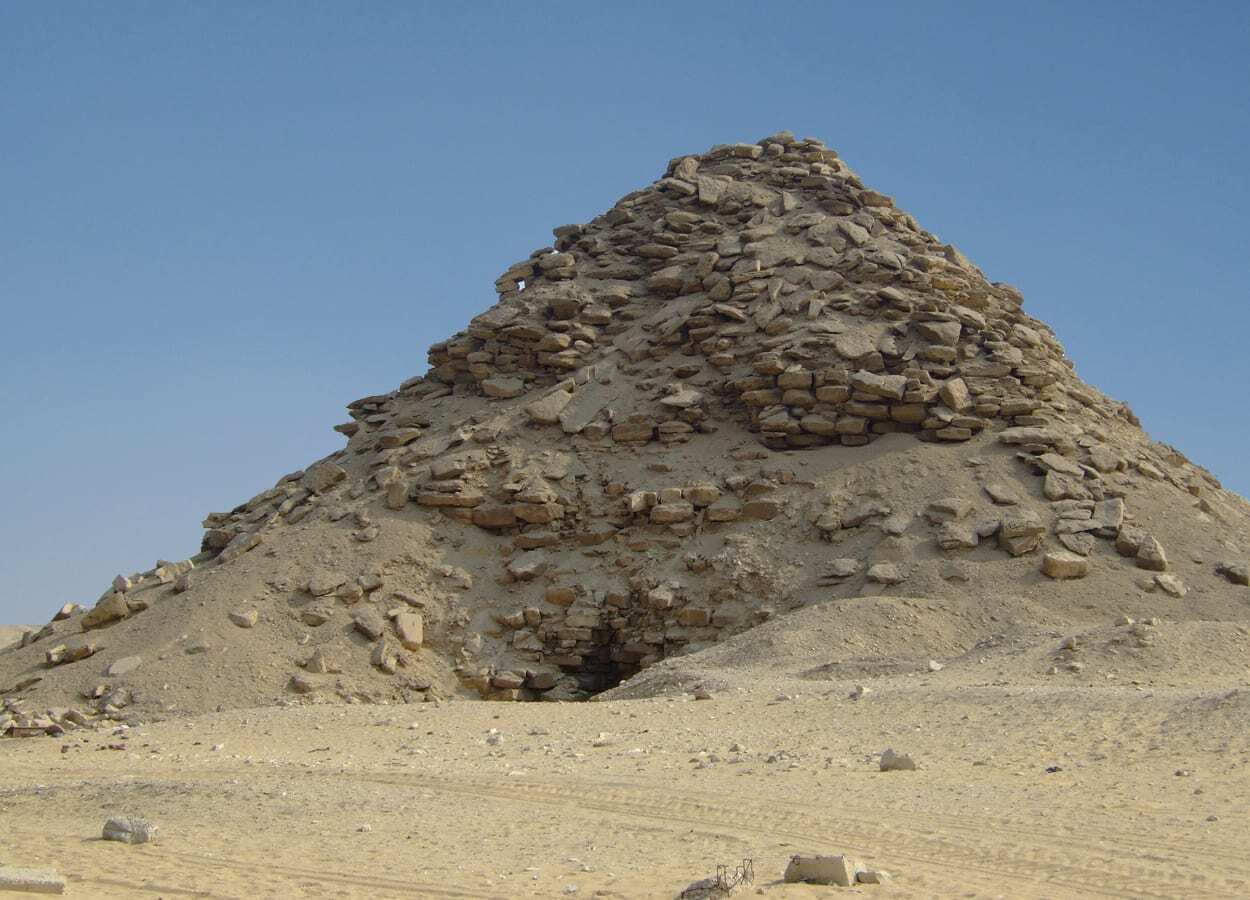 https://www.heritagedaily.com/2021/01/the-ancient-egyptian-pyramids/134365
https://www.heritagedaily.com/2021/01/the-ancient-egyptian-pyramids/134365No, what I'm trying to say is that some people theorize the 3 or 4 big/famous pyramids don't fit into the picture of the evolution of the pyramids;
First their was a period of increased 'better' construction leading up to the one like Giza but after that they were never able to build similar ones in the ages to follow; So they went from this:
To this:
but then one would expect how to build these things so the ones coming after would become bigger/better etc. However this is not the case:
https://www.heritagedaily.com/2021/01/the-ancient-egyptian-pyramids/134365
No I don't agree with it either, but it is often put forward by supporters of the ancient alien theories.That is a big assumption. What if they did not want to do so? Perhaps there was a lack of resources at later builds. It is dangerous to project things that we find "normal" onto a cultures from thousands of years ago.
but then one would expect how to build these things so the ones coming after would become bigger/better etc. However this is not the case
I think Ravi's on the right lines.That is a big assumption. What if they did not want to do so? Perhaps there was a lack of resources at later builds
https://en.wikipedia.org/wiki/Ancient_EgyptKings also made land grants to their mortuary cults and local temples, to ensure that these institutions had the resources to worship the king after his death. Scholars believe that five centuries of these practices slowly eroded the economic vitality of Egypt, and that the economy could no longer afford to support a large centralized administration.[
It is pretty obvious that building a massive structure like the pyramids requires an enormous outlay of effort and manpower. Perhaps later pharaohs were unable to muster that workforce. A plague, a war, a famine, a flood ...all are things that would take a higher priority than bankrupting a country for the building of a tomb. Know-how isn't sufficient to do the actual building.but then one would expect how to build these things so the ones coming after would become bigger/better etc. However this is not the case:
Jim Corsetti claiming on Joe Rogan that there is no evidence in the Giza pyramids that they were built as tombs:
Kemetism
https://en.wikipedia.org/wiki/Kemetism(also Kemeticism; both from the Egyptian kmt, usually voweled Kemet, the native name of ancient Egypt), also sometimes referred to as Neterism (from nṯr (Coptic ⲛⲟⲩⲧⲉ noute) "deity"), or Kemetic paganism, is a neopagan religion and revival of the ancient Egyptian religion and related expressions of religion in classical and late antiquity, emerging during the 1970s. A Kemetic or Kemetic pagan is one who follows Kemetism.[1]
